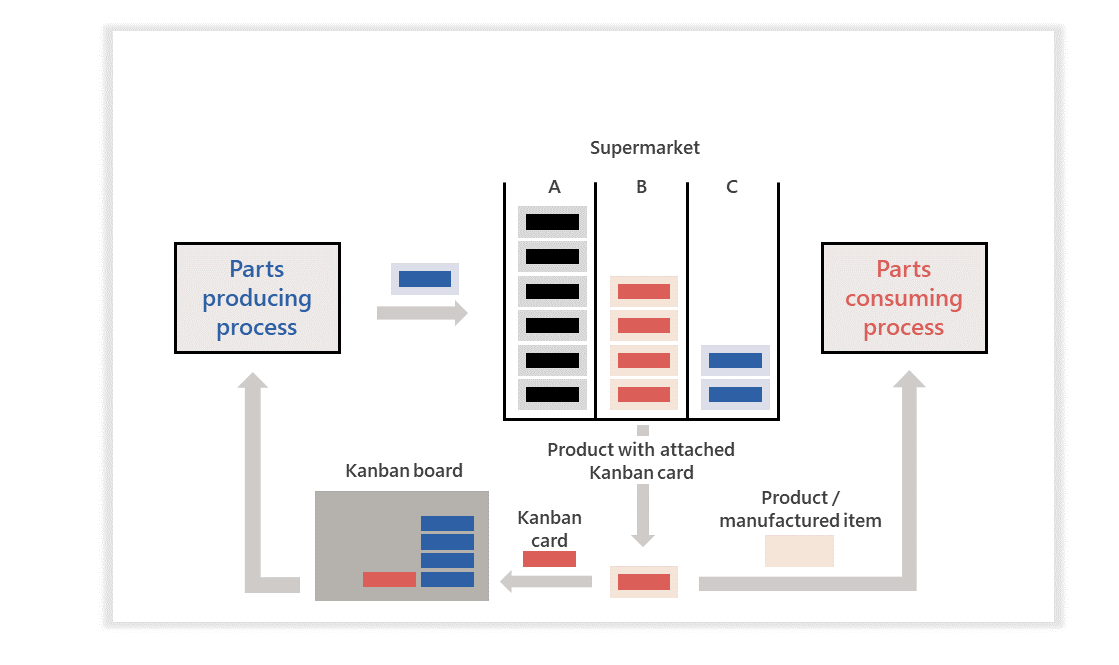Lean manufacturing techniques and processes
In this section, you explore key techniques and processes that support lean manufacturing. These methods help streamline production, eliminate waste, and enhance efficiency across the entire supply chain. From cell and line design to understanding value streams and kanban systems, mastering these concepts is crucial for driving continuous improvement and creating value for the customer.
Identifying value for the customer
When identifying the value, you specify what creates value from the customer's perspective:
- The customer defines the value of product in a lean supply chain.
- Value-adding activities transform the product closer to what the customer actually wants.
- An activity that does not add value is considered waste.
Value stream
The value stream is the sequence of processes from raw material to final customer or from product concept to market launch. If possible, look at the whole supply chain.
The value stream is modeled as an operating unit in Supply Chain Management, which allows the use of the value stream as a financial dimension.
Value stream mapping is an important tool to help model the lean transformation. The value stream consists of activities that are required to design and make a family of products or services that are undertaken with a group of functions that are linked together. These linked functions chain processes from the point of customer specification to the raw material source, which is the lean manufacturer's inventory.
One objective of the value stream is to correctly specify value to the ultimate customer. Another objective is to analyze and focus so that it does everything from product development and production to sales and service in a way that actions that do not create value are removed and actions that do create value proceed in a continuous flow as pulled by the customer.
The future state value stream can be modeled in Supply Chain Management as a production flow. All processes of the value stream are modeled as process activities inside production flows. Many production flows can make up a value stream.
Therefore, the value stream, along with the production flow, is used to model the structure of lean manufacturing in Supply Chain Management.
Creating a production flow
Production flows are the flow of material and products throughout work cells and locations for a specific production or supply scenario. A production flow can also be described as a sequence or small network of process or transfer activities. In other words, it's creating flow wherever possible in the process.
You can use a one-piece flow by linking all the activities and processes into the most efficient combinations to maximize value-added content while minimizing waste. With this approach, the waiting time of work in progress between processes is eliminated; hence, adding value more quickly.
The term feeder flow is used when products of a production flow are used in another flow.
Production flows are introduced as essential components of lean manufacturing because they:
- Define the process and transfer activities of the value stream.
- Support the kanban rules in defining activities that a kanban goes through.
- Provide an activity-based context for the planning and production processes.
- Establish a cost context for the various kanban production scenarios.
To support continuous improvement, the production flows are implemented in time-effective versions. This implementation allows you to copy an existing production flow version, including all related kanban rules, to a draft version of the production flow and then model the future stay production flow before validating and activating it for production.
The activity-based model allows the setup of a wide range of scenarios, without adding complexity for the production (shop) floor workers, because all scenarios use the same activity-based user interface.
Introduction to kanbans
The word kanban means "visible record" in Japanese. Kanban has been adopted by many industries as a method of controlling production and internal supply.
When a kanban has been consumed, it should be passed or triggered to the source of supply to replenish it. This source of supply is defined through the production flow activities that the kanban is linked to, providing a definition of how the kanban is filled. Kanban rules in Supply Chain Management are important to production flows because they define the activities that a kanban goes through.
The value stream is different from the classical material requirements planning (MRP) approach where individual items are linked to individual and independent resources or resource groups such as work centers and workgroups. The value stream unifies the process for a product family in a top-down approach.
The diagram below shows the kanban process and how it is used.
